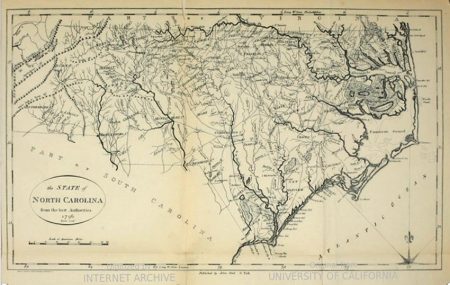Exactly Who Do You Think You Can Count On?
The current Republican plan to send the state into another redistricting battle.

Photo: Tim Barnwell
Legislative News by Nelda Holder –
A funny thing happened on the way to my writing this column.
I had planned to discuss the state’s legislative push (on the majority/Republican side) for yet another redistricting process that they hoped would gain one more Republican congressman down East and increase their majority to 11 of 14 NC Congressional seats. This attempt proved successful (see more below).
But then this article by Doug Book Clark appeared in the October 30 ProPublica, titled “God’s Chief Justice.” I suggest you read it … every word. Now. (Note ProPublica’s own reference to itself is “a nonprofit newsroom that investigates abuses of power.”)
It is a powerful article about partisan gerrymandering in this swing state, and about (Republican) Chief Justice Paul Newby’s ostensible engineering of a majority opinion declaring “that partisan gerrymandering was legal and that the Democrat-led court had unconstitutionally infringed on the legislature’s prerogative to create electoral maps.” That 2023 decision led to the abandonment of an evenly split NC delegation “reflecting the state’s balanced electorate,” and in 2024 the state sent 10 Republicans and four Democrats to Congress.
This, ProPublica points out, provided a six-seat swing “that enabled the GOP to take control of the US House of Representatives plus Republican control of every branch of federal government.
And it is at this point that I may begin to discuss the current Republican plan to send the state into another redistricting battle.
Let’s Make This Perfectly Clear
- Federal law forbids discrimination on the basis of race or ethnicity, but not partisanship, and districts must have nearly equal populations. North Carolina holds 14 congressional seats, which in this decade—based on the national census (2020 cycle)—have (so far) been assigned as required. (Note: Information about the congressional districts was sourced from Ballotpedia online.)
- After the 2020 Census, the NC General Assembly adopted a new set of district boundaries used in 2021, followed by remedial maps used in 2022. New congressional maps were ordered to be used starting with the 2024 elections.
- The NC League of Conservation Voters filed a lawsuit in November of 2021 (Wake County Superior Court) challenging the validity of the state’s enacted legislative and congressional maps for, among other things, “diluting the power of North Carolina’s Black citizens.” The remedy asked for was to set aside the “unlawful” enacted plans and require the legislature to draw new maps.
- The NC Supreme Court, with a 4-3 Democratic majority, ruled on February 4, 2022, that the congressional and legislative maps were unconstitutional, and ordered them redrawn by February 18. The Wake County Superior Court appointed three former judges to act as redistricting special masters on February 15 (Democrat Tom Ross, former Superior Court Judge; independent Bob Orr, former state Supreme Court Justice; and Republican Bob Edmunds, former state Supreme Court justice.
- On February 23, 2022, the Wake County Superior Court ruled to approve state legislative maps redrawn by the General Assembly. The Assembly’s redrawn congressional map was struck down, and a map drawn by the redistricting special masters was enacted.
- On April 28, 2023, the NC Supreme Court, now with a 5-2 Republican majority, overruled the February 4, 2022, decision that the November 2021 congressional map adopted by the legislature violated the state constitution, and dismissed a challenge of partisan gerrymandering concerning the congressional district boundaries.
- The NC General Assembly adopted new legislative district boundaries in October of 2023. Votes were strictly along party lines, when the NC Supreme Court overturned that Court’s own February, 2022 decision, thus vacating the 2021 and 2022 maps. The Court ruled that that the General Assembly should develop new boundaries, starting with the 2024 elections.
Confusing?
There’s more. I’d suggest you browse through the chronology at the Ballotpedia site. But from this outline you’ll see that district boundaries generate a lot of political heat, and the redistricting which was just approved in the 1st Congressional District has presented the gnarly business in bright lights.
There is a current redistricting lawsuit begun two years ago including plaintiffs Common Cause, the North Carolina NAACP, and individual voters, and another lawsuit filed by a group of Black and Latino voters. And in late October, federal judges allowed the 1st District suit to be added to this action.
According to reporting by Lynn Bonner in the October 30 NC Newsline article “Federal judges allow NC redistricting opponents to add the new 1st District to their lawsuit,” the following issues swarm the new district:
- Republicans redrew the district at the behest of President Donald Trump, who is seeking to maximize Republican US House wins in the midterm election.
- The latest 1st District boundaries, established last week, dismantle the Black Belt, counties in northeastern and eastern North Carolina with a bloc of Black voters. Those voters helped elect Black members to Congress since 1992.
- The 1st District was the only competitive congressional district in the state last year. Incumbent Democratic Rep. Don Davis narrowly won a second term.
- The group of plaintiffs including Common Cause, the NC NAACP, and individual voters, says legislators made the district even worse in retaliation for opponents filing the lawsuit.
Nelda Holder is the author of The Thirteenth Juror – Ferguson: A Personal Look at the Grand Jury Transcripts.








